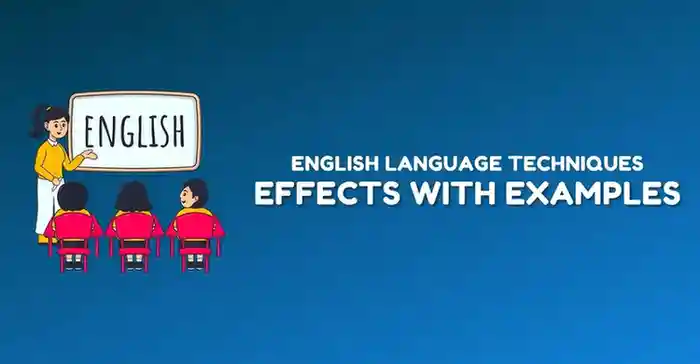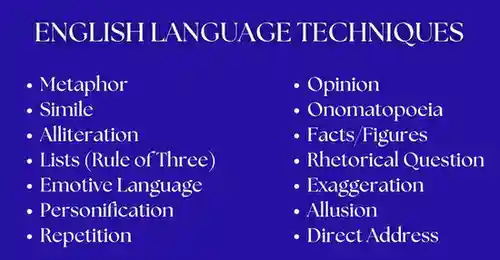Lists of GCSE Maths Topics
Want to know what GCSE Maths topics you have to study for your exams? Maths is really a great choice for your GCSE, as i ...

Looking for English language techniques or English techniques? If yes, you are probably an English literature student. You do not need to worry at all—we have explained the most important English language techniques in this blog. These techniques create powerful impact when used correctly, and this guide will help you understand each of them clearly.
The best way to understand anything is through examples, which is why each technique below includes examples and effects. If you’re working on assignments, go through all examples of techniques mentioned here—or seek guidance from a good assignment helper.
Literary (or linguistic/figurative) devices are techniques writers use to express emotions, mood, or themes effectively. These devices include metaphors, repetition, emotive language, personification and more—all helping writers create strong impact.
You are often asked to use these devices in literature assignments. For example, instead of saying “Everyone has a role in life”, Shakespeare used the famous line: “All the world’s a stage…” This is remembered because of effective technique—not simple language.
If you want to improve writing skills, these techniques will help you a lot—even in assignment writing.

Below is the explanation of all these techniques, along with examples and their effects on readers.
Metaphor is a direct comparison between two things, unlike a simile which uses “like” or “as”. It carries emotional depth and is widely used in literature.
Example: “Life’s but a walking shadow.” — Shakespeare
This metaphor shows life as brief and empty, helping readers understand Macbeth’s emotional state.
Effect: Metaphors strengthen the message, making abstract ideas easier to understand.
Simile compares two things using “as” or “like” to create vivid imagery.
Examples: “Cool as a cucumber”, “Smooth like the ocean”, “Loud like a thunderstorm”.
Effect: Helps readers visualize exactly what the writer intends.
Alliteration is the repetition of consonant sounds at the beginning of words to create rhythm and emphasis.
Example: “Big bad bludger banged against my broom.” — Harry Potter
Effect: Adds rhythm, energy, and memorability to the sentence.
Items listed in threes are naturally more memorable and satisfying to readers.
Example: “I came, I saw, I conquered.”
Effect: Creates completeness, power, and rhythm.
Words that evoke emotions in readers—used strongly in persuasive writing.
Example: “Cold, bitter voice…” — To Kill a Mockingbird
Effect: Helps readers feel what the writer wants them to feel.
Giving human qualities to objects or nature to create vivid imagery.
Example: “The waves danced.” — Wordsworth
Effect: Creates a lively scene that readers can emotionally connect with.
Repeating words/phrases to create emphasis.
Example: “I have a dream…” repeatedly used by Martin Luther King Jr.
Effect: Creates rhythm and reinforces the message.
An opinion expresses personal beliefs or viewpoints.
Example: “Four legs good, two legs bad.” — Animal Farm
Effect: Shows power of ideology and manipulation.
Words that imitate actual sounds.
Example: “Tinkling, jingling…” — Poe’s *The Bells*
Effect: Helps readers hear the scene, enhancing sensory experience.
Use of data or accurate information for credibility.
Example: *The Curious Incident of the Dog in the Night-Time* uses facts to show the character’s thought process.
Effect: Adds realism and strengthens arguments.
Questions asked for effect, not answers.
Example: “If you poison us, do we not die?” — Shakespeare
Effect: Makes the reader think and reinforces arguments.
Overstating something for humor or dramatic effect.
Example: “Ships hung in the sky like bricks don’t.” — Douglas Adams
Effect: Adds humor and creates vivid imagery.
Reference to famous people, events, or works.
Example: Numerous historical allusions in *The Great Gatsby*.
Effect: Deepens meaning for readers who recognize the reference.
Speaking directly to the reader.
Example: “Reader, I married him.” — *Jane Eyre*
Effect: Creates intimacy and direct connection with the audience.
English language techniques make writing vivid, engaging, and effective. Any writer who masters these techniques improves the impact of their writing and connects better with readers.
This blog covered 14 essential techniques along with examples and their effects. Use them in your assignments or creative writing to take your work to the next level.
Our ability to use language techniques is essential for all forms of written assessment including traditional essays ungraded response tasks inventive compositional assignments and persuasive writing tasks. Our comprehension and analysis of English texts become more precise when we maintain extensive awareness of language techniques alongside the ability to create descriptive writing.
We examine the Baldwin effect as a natural selection process which leads language learners across multiple generations to make previously acquired linguistic features part of their innate knowledge.
The Pearson correlation coefficient becomes a common language effect size when it demonstrates the statistical probability of obtaining one variable value when a threshold is established on another variable.
Identifying Simple Language Techniques including assonance/alliteration, for repetition of consonant sounds establishes the literary device known as alliteration. Hyperbole for creating dramatic impact Writers can employ hyperbole through excessive exaggeration of objects events people or ideas. And Tone / Mood, Repetition / Rhyme or Onomatopoeia.
Let's Book Your Work with Our Expert and Get High-Quality Content

Loved reading this Blog? Share your valuable thoughts in the comment section.
Add comment